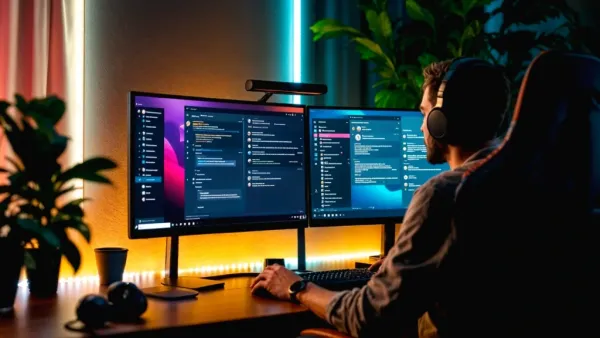
A handful of years ago, it was considered science fiction that a machine could generate another machine’s code. Coding was considered a proper art form, a blend of logic and creativity that only humans could master.
Fast forward to today, and our AI training buddies, such as GitHub Copilot, ChatGPT, and Tabnine, are doing more than making small code suggestions or commenting on other people’s code; they are capable of not only drafting complete applications from scratch or debugging any software, but are also potentially able to recommend architecture.
The line between human developer and machine companion is blurred – hence the euphoria and existential dread.

So, in this new world of intelligent automation, the question is raised – who wins with code – the machine or the developer?
The growth of Artificial Intelligence in software development has grown massively over the last couple of years. AI models trained on billions of lines of open-source code, huge language models (LLMs) such as OpenAI’s GPT-4 and Google’s Gemini, can now write, translate, and improve code across multiple programming languages.
When a developer types a prompt like “write a Python script to scrape a webpage,” the AI immediately drafts functional and clean code. More experienced users can do even more, such as asking the AI to build a complete front-end, debug existing applications, or optimize performance bottlenecks.
Tech giants have embedded AI into the heart of modern development environments:
As a result, we are now at a stage where developers are not coding alone, but coding with an intelligent assistant that can learn from context, recall project details, and copy user style.
The primary benefit is the pace. A developer might otherwise spend hours investigating syntax or debugging the same pattern over and over, but now produces results in seconds. For routine programming jobs, creating boilerplate code, formatting the code, generating a suite of tests, etc. AI tools are revolutionary because of these reasons:
Human developers are still irreplaceable, however, due to these reasons:

There is an emerging consensus among technology leaders that AI acts as an enhancement tool for developers, not a replacement. In 2025, the most productive environments will consist of human-AI partnerships, where the majority of mechanical work is handled by the machine, and the human charts the direction and meaning.
For example, you can picture a developer as a film director and AI as the cinematographer. The AI is responsible for the technical execution of the shot, lighting, and composition, while the human crafts the story and outlines the vision.
A survey conducted by Stack Overflow at the end of 2024 found that 82% of developers use AI assistants frequently or daily, while only 9% trust AI to code independently. Developers actually describe the working relationship as co-piloting, not automation. The AI handles the little things – i.e., boilerplate code, syntax, and documentation- and allows humans to think about architecture, design, and innovation.
This model of collaboration has already shown signs of success. Microsoft has conducted internal developer productivity studies, which found that AI-assisted teams were 55% more likely to meet deadlines and 30% less likely to experience burnout. That reduction in cognitive load allows creativity to flow more freely.
Nevertheless, this symbiosis raises concerns that lie beyond efficiency. If AI completes 60% of a junior developer’s work, what happens to entry-level jobs, which are often referred to as the traditional training grounds for experts of tomorrow?
Some experts have warned that over-reliance on AI can diminish people’s fundamental skills. “If the next generation of programmers never suffers through debugging,” Professor Meera Nanda from IIT Bombay. “They may not learn the mental models that make them great engineers.”
In addition, it’s conceivable that AI-generated code could entail legal risks under intellectual property law. If the AI model trains on copyrighted code, its outputs could reproduce that code, either intentionally or inadvertently. So, companies will need to navigate a more legal gray area around authorship, ownership, and accountability.
Ethically speaking, there is also the philosophical question: Should we trust machines with decisions that can impact a person’s safety, finances, or privacy? If AI writes code that can be used in healthcare or defense applications, a small error has an acceptable impact on humans.
Regulators are beginning to take action. The European Union’s AI Act and other frameworks will be the first to set requirements for “human-in-the-loop” orders, outlining that people remain accountable for any AI-assisted output.
Actually, there are no winners or losers, as this is not a contest. It is a collaboration toward a more equitable balance of power for coexistence. The AI-enabled code writing is the product of decades of automation, designed to remove drudgery while enhancing your creativity. However, machines are still machines, and they create code without the human capacities of intent, ethics, and creativity.

Humans can and must evolve. Developers who might want to survive or thrive in an AI-enabled world must adapt to their workings and learn to shepherd, critique, and collaborate with machines. Just as code-writing development itself ushered in a new digital age, developers who evolve will be architects of the new one, and those developers who do not will not survive in an environment characterized by productivity without perfection.
Ultimately, the real “winner” is not AI or the developer, but their collaboration, combining the procedural certainty of coding with the intuitive capabilities of the human brain. Combining AI and humans, both in dialogue, key by key, will facilitate technology that increases productivity, fooling us into believing we understand life as we know it.
The future of software and the practice of writing code will be accomplished collectively, not by either entity on its own, but collaboratively, where intelligence is indistinguishable between humans and machines.